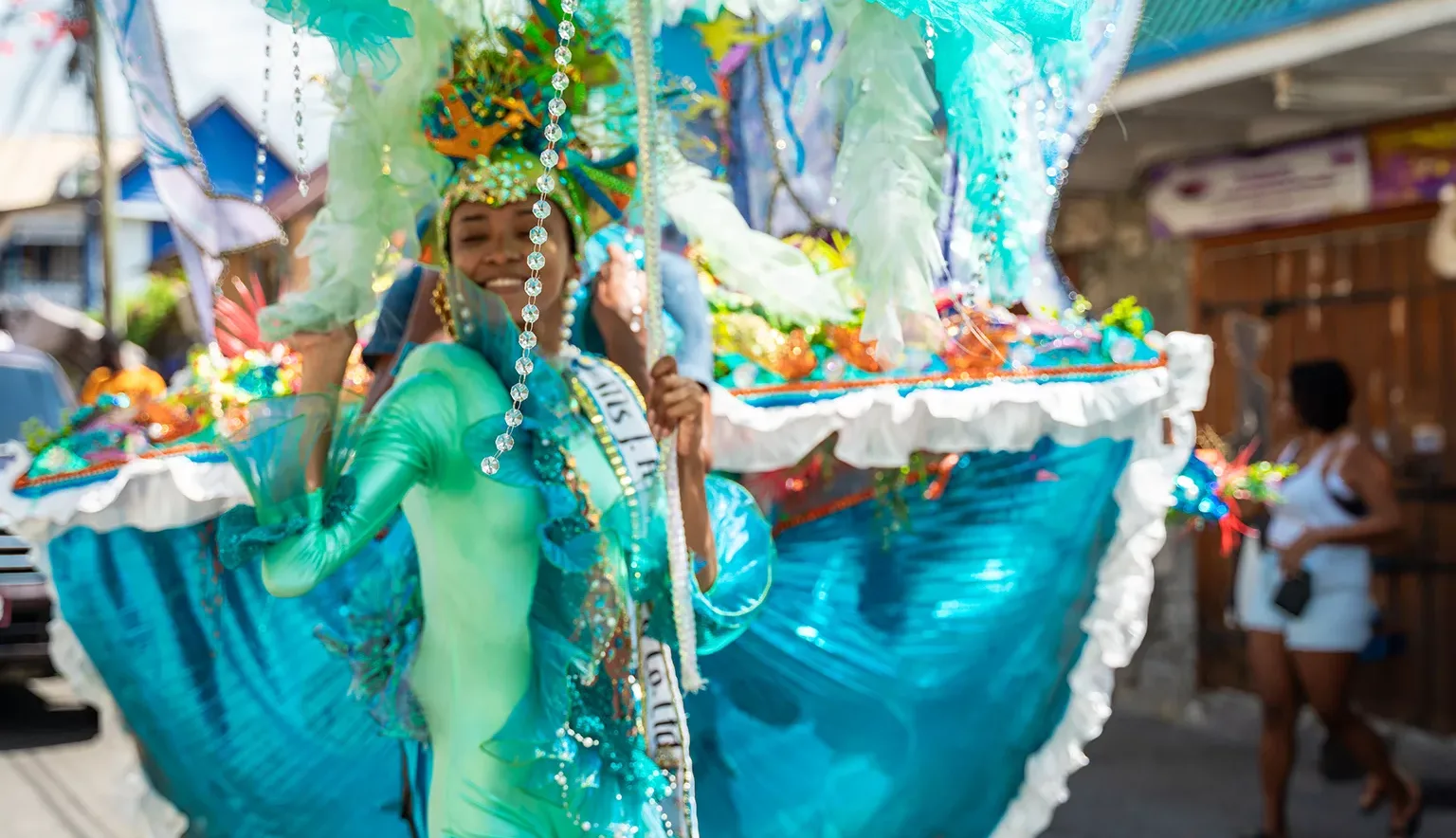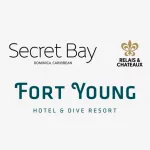With its preserved landscapes and pristine shorelines, Dominica is often referred to as the “Nature Island of the Caribbean” due to its breathtaking scenery and dramatic terrain, which commands attention as it extends into the turquoise waters of the Caribbean Sea.
INTRODUCTION
As part of a long arc of small islands in the Lesser Antilles archipelago, Dominica is a bijou and unique destination with an incomparable beauty.
Fringed with black and gold sand, peaceful bays are nestled within a diverse coastline with a tropical maritime climate nourishing Dominica’s volcanic topography of rugged mountains, waterfalls, rivers, and geothermal hot springs, covered by a verdant canopy of lush rainforest where adventurers can go horseback riding. The island’s dramatic peaks are emphasised by cascading waterfalls juxtaposed with deep valleys, creating a hiker’s paradise.
When exploring, there is ample opportunity to enjoy panoramic vistas by hiking the Waitukubuli National Trail, which spans from north to south and is one of the most famous in the Caribbean. The landscape is dominated by mountains, with the highest point at Morne Diablotins standing an impressive 4,747 feet above sea level.
The youngest island in the Caribbean chain, at a sprightly 26 million years old, Dominica has a solid social history dating back to 3,100 BCE when various tribes made it their home.
Today, the remaining Indigenous population of pre-Columbian Carib Indians, officially known as Kalinago, inhabit a 3,700-acre reserve on the island’s eastern coast. When Christopher Columbus invaded and colonised the island in 1493, he ignored the Kalinago name of Waitukubuli and renamed the country Dominica.
Nature may be the country’s beating heart, but the people are its soul. The island’s cultural tapestry is woven with European and African influences, creating a unique and inviting atmosphere for visitors to embrace its warm and welcoming spirit. Dominicans take pride in their reputation as the world’s friendliest hosts, as recognised by Condé Nast Traveller magazine, and it’s easy to see why once you experience their hospitality.
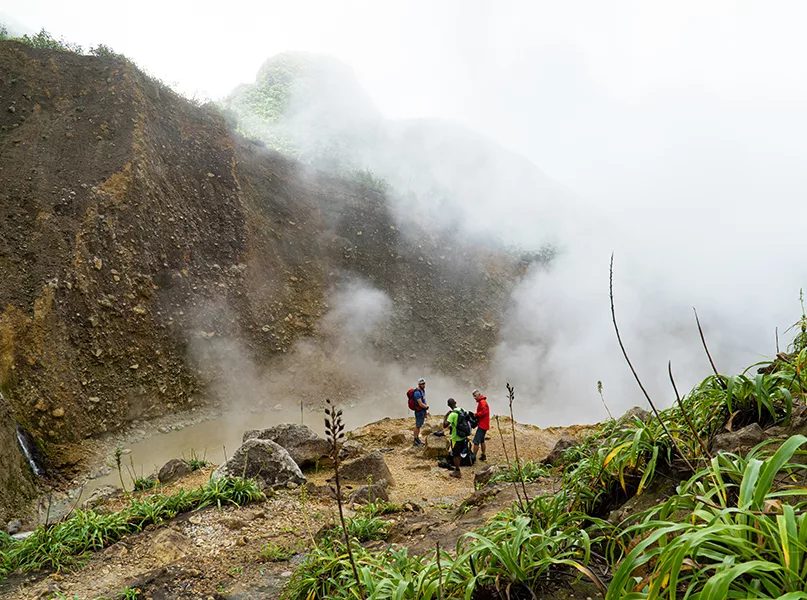
Q&A WITH DISCOVER DOMINICA AUTHORITY
The tropical island of Dominica boasts rugged physical features enveloped in a fertile shroud and is brimming with natural wonders and Creole culture. Andia Ravariere, Destination Marketing Manager at Discover Dominica Authority, highlights the destination’s adventurous side and explains its appeal to visitors, along with what makes it distinctly Dominica.
Firstly, can you talk us through the origins of the Discover Dominica Authority and its initial vision and mission?
Andia Ravariere, Destination Marketing Manager (AR): The organisation was initially known as part of the National Development Cooperation (NDC).
That cooperation held two portfolios – one was the development and marketing of the destination: the other spoke to the investment portfolio in terms of seeking investors for the development of the destination. In 2007, NDC was dissolved, and from it, we established Discover Dominica Authority (DDA), a destination marketing organisation that promotes and develops products.
The promotion department enhances products by offering services and training for individuals within the sector. They are also responsible for the meetings, incentives, conferences, and exhibitions (MICE) certification awarded to our service providers, the accommodation sector, and restauranteurs. Furthermore, specific standards and amenities are needed to qualify for accreditation by DDA.
Moreover, they work with different forms of training, in addition to liaising very closely with the forestry division, which oversees most of the sites. The natural iconic sites Dominica is known for, such as the hiking and sea trails, all work with other departments, including the government, to ensure the product is aligned with the destination’s goals and objectives.
The Dominica Festival Commission (DFC) is another DDA department that oversees the production aspects of different festivals.
Our mission is to market Dominica, keeping us at the forefront of the minds of visitors and travel agents we work with for different stakeholders. We genuinely work to develop the island to align with our marketing.
What unique attributes make the island’s residents happy and welcoming?
AR: I think it’s the relaxed vibes of the island. We are very open and generally welcoming; that is part of our unique identity. I was looking at a travel influencer who came to Dominica last year, and she could not stop talking about how comfortable and safe she felt here.
When locals heard she was alone, they started looking out for her, giving her a sense of freedom. By the time she left the island, she had ended up with many friends and said it was the friendliest and safest place she’d visited. It is essential for solo travellers, especially female ones, to feel secure.
I don’t think anyone has left here without mentioning how beautiful this destination is – not because of our landscape, but because of our people. Many have chosen to relocate here with fascinating stories of why they returned.
At the heart and soul of this extraordinary place is the warmth of its people with a welcoming and inclusive nature – our arms are open and expansive; we want visitors to enjoy Dominica.
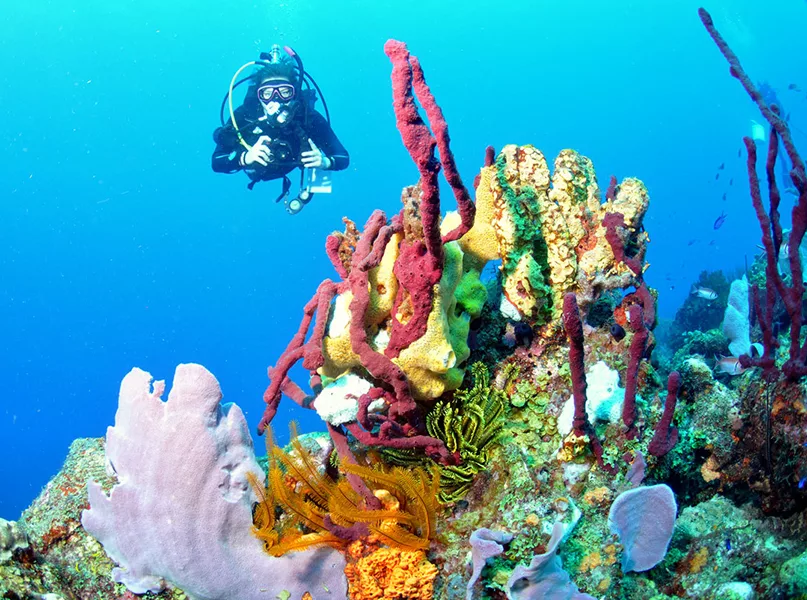
How is Dominica embracing sustainable and environmentally friendly travel experiences?
AR: The majority, if not all, of our properties are very much concerned about the natural environment as they have been built within it.
For example, Secret Bay, a hideaway on Dominica’s northern tip, is renowned for its sustainability efforts. When it was built, the owner refused to cut down the trees and preserved the natural landscape, including a paddle mangrove. The resort aims to leave a minimal environmental footprint, reflecting the island’s commitment to conservation.
We always say that we do not offer the typical luxury that you see; we offer barefoot luxury. Everything we provide is unique and niche because we understand that we are a natural environment; we love and respect it, and all our efforts are sustainable. Dominica is one of the few destinations where you can see a sperm whale all year round as they are residents here.
However, our government has put many policies in place to ensure Dominica’s waters remain pristine, and we are one of the few destinations that does not have to sink anything to create an underwater museum because we have not lost the beauty of the coral reefs. Thanks to our sustainability efforts, even our waterfalls, which are all over Dominica, are safe enough to drink.
Our landscape remains rich, with sustainable development preserving the natural environment. Our celebrated cultural landscape is crucial to our identity and must be safeguarded alongside conservation efforts.
The World Creole Music Festival at the end of October is part of Creole season, although everybody is excited from the beginning of the month as every Friday, we have Chapo Pai Day, which translates as straw hat, where everyone comes to work with their headwear and a piece of Madras – an Indian cloth.
If you’re a foodie, you’ll experience tasty cuisine and festivities on every corner while listening to traditional music play with the beating of the drums and people dancing. It cannot be explained; it can only truly be experienced.
How do you market Dominica as a destination, and what type of traveller does it appeal to?
AR: Dominica’s marketing plans this year highlights its unique factors. Whether it’s a wedding or a family vacation, visitors can expect an adventurous experience in nature.
Dominica offers immersive hikes through history, dives in fresh oceans with coral reefs, and river spa experiences. Couples can even get married while diving or on volcanic beaches under cascading waterfalls.
We are known for adventure in nature, and we have the longest hiking trail in the region. The Kalinago people used the same trail, as did runaway slaves, so every segment has a story.
Dominica is the only destination with a sea trail, a counterpart of the hiking trail that goes the length of the island. Aside from these activities, there is a healing spirit on the island, and the Dominicans greatly respect the environment and Mother Nature.
The island’s mountainous terrain, which appeals to adventure seekers and families, is perfect for unplugging and connecting with nature. Our target market also includes people concerned about sustainability and seeking authentic, unique experiences.
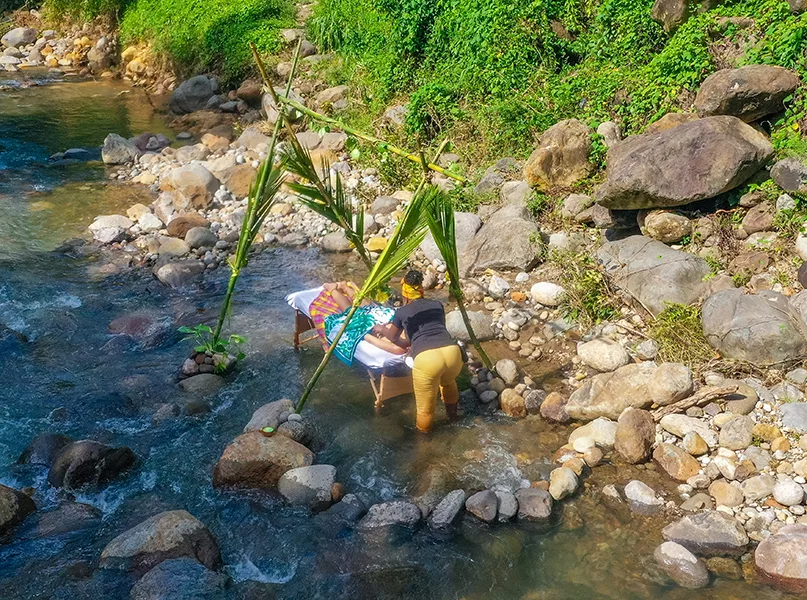
Are there any interesting or exciting projects you would like to highlight?
AR: Most projects are funded by the Citizenship by Investment programme, including the expansion of existing airport infrastructure and ongoing construction of Dominica’s International Airport.
Properties are also coming along, such as Tranquility Beach Resort, and Sanctuary Rainforest Eco Resort and Spa, which is particularly special as it has submerged rooms covered with grass and earth in a heavily forested area of Roseau Valley.
Furthermore, the longest cable car in the world will take you from Roseau Valley up to Boiling Lake, a thermal spring where you can experience the entire area, including waterfalls, naturally powered spas, and amazing views.
There are currently many tourism projects, and we have also broken ground on the marina in Portsmouth as we position ourselves in the luxury yachting sector.

What trends, would you say, are transforming the tourism industry on the island?
AR: We are lively people, know how to have a good time, and are happy to celebrate anything and everything. As an events destination where people can have fun, carnivals and festivals are entwined with our culture and nature, and even Bike Festival aligned perfectly because the individuals did a huge tour of the island.
The island also has a bar culture, which means you will see a local, cosy little wooden shack in every village. Those were also part of the Bike Festival tour; bikers would stop at highlighted spots, play music, have fun in the natural environment, and take scenic photos. It was all tied into the culture and natural landscape of the island.
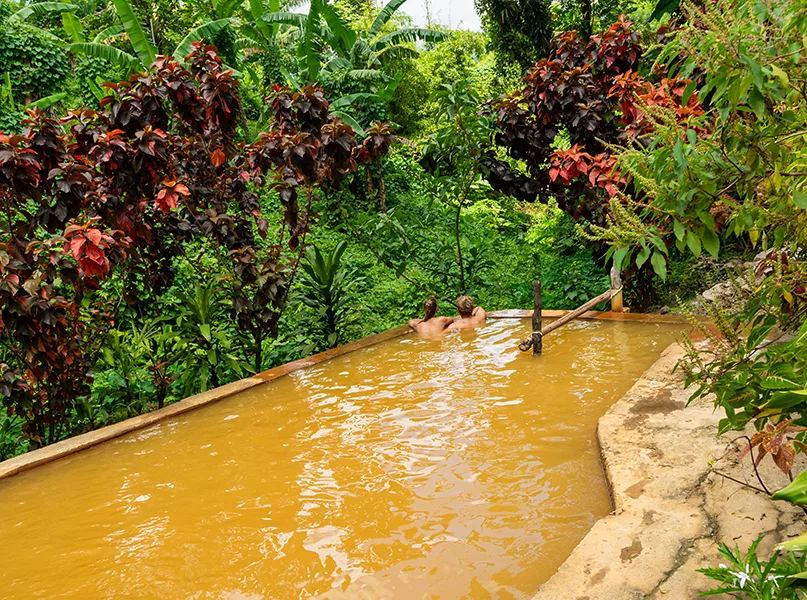
What challenges does the tourism industry in Dominica face, and how does the authority navigate them?
AR: One of the main challenges is access, which will continue until Dominica International Airport is completed. It’s not just Dominica; a majority of smaller islands experience that issue as well.
Getting to this destination can be challenging and expensive due to limited direct flights. However, the government is working on improving connectivity through feeder flights.
For individuals coming from the UK, flying into Barbados is an option as we have a close partnership with airlines like InterCaribbean Airways and British Airways. Additionally, American Airlines offers a direct service from Miami, and the tri-state area has a significant Dominican diaspora.
When travelling to the island, you can book a flight from New York to Miami and then to Dominica. Alternatively, you can fly from New York to Puerto Rico and then take a connecting flight with Silver Airways, which has partnerships with Delta Air Lines, United Airlines, and JetBlue. Our government is also working with regional airlines such as Sunrise Airways and Winair to improve access.
While some international passengers may need to travel indirectly, we aim to minimise the need for overnight stays.
Are you optimistic about the future of tourism in Dominica, and how do you see it developing in the years ahead?
AR: We are very much focused on the sustainability, conservation, and preservation of the natural environment.
The island is unique and distinctly Dominican. Research shows that over 47 percent of the UK market is looking for new, different travelling experiences, and it’s the same in France and the US. That alone tells you we are positioned to capture that percentage of the market.
We must tap into this opportunity as we are still a relatively new vacation destination for quality tourism. Therefore, I’m very optimistic about where we are and how much market share we could secure.
What we need to do is position ourselves in the hearts and minds of people, so our marketing has to be aggressive to let them know that Dominica is a prime option.
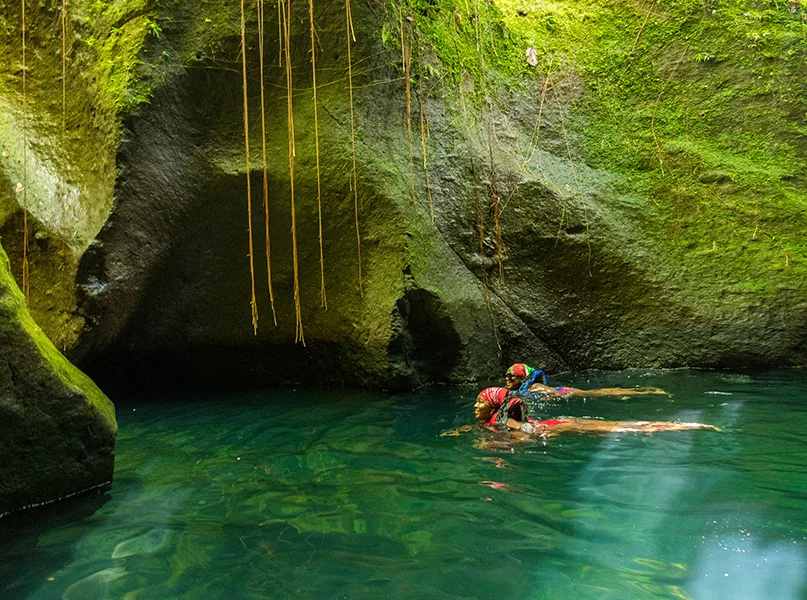
DOMINICAN FESTIVALS IN FOCUS
Dominica has a strong Creole heritage, contributing to its rich cultural identity. The island hosts three main festivals, including Mas Domnik – known for its authentic masks, making it the only Caribbean destination to offer such a traditional carnival experience. This month-long celebration features calypso competitions, pageantry, folklore characters, and bouyon music.
The Dominica Jazz ‘n Creole festival, meanwhile, is a unique event that showcases the fusion of jazz with Creole culture. The iconic celebration attracts musicians from all over the globe and has an inviting ambience as patrons enjoy the food and beverages on offer. Dominicans like to say, “we are jazzing up our culture”.
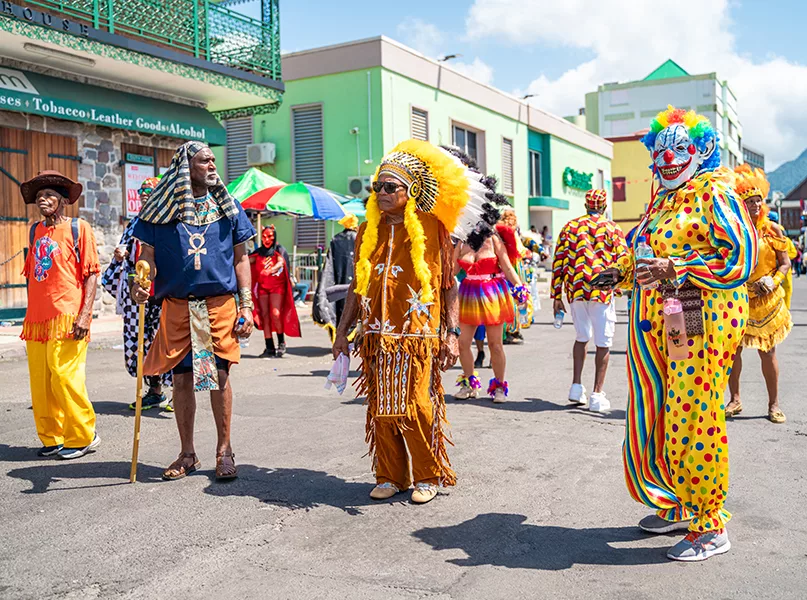
The World Creole Music Festival is one of the country’s most renowned events and the largest and most-attended carnival in Dominica, whilst the first-ever Dominica Bike Fest held in July this year attracted adrenaline enthusiasts and culminated in an island-wide tour.
Elsewhere, the recently launched Flavors of the World Festival not only features Dominica’s Creole gastronomy but also includes different destinations from around the world, such as China, Venezuela, Guyana, Trinidad, the US, and France. A chef from each area prepares food for gourmands to taste as part of an ultra-cultural experience where local music, performances, and traditions are on display.
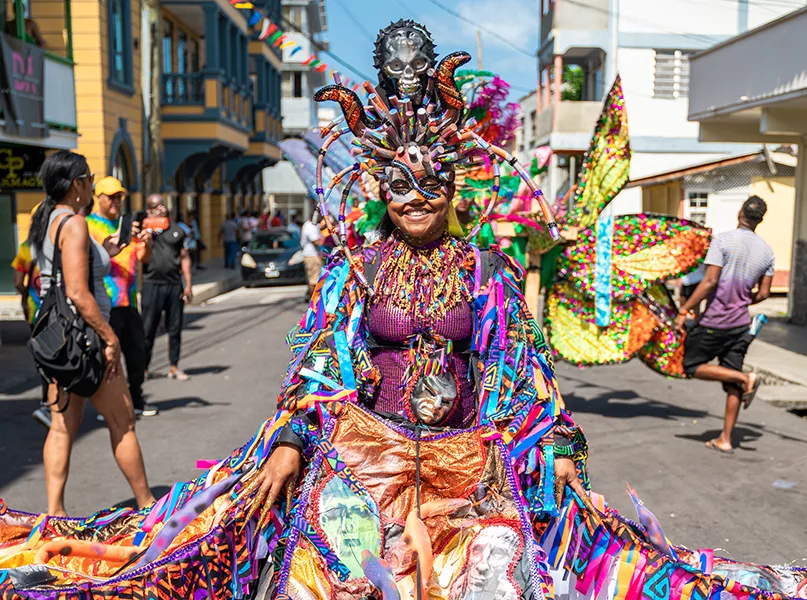
OUTLOOK RECOMMENDS
Eat:
FOR A RELAXED VIBE…
Escape Beach Bar is an oceanside eatery that serves colourful cocktails and Caribbean dishes made with fresh, seasonal ingredients. Tucked away among palm trees and tropical flowers, guests can enjoy a barefoot experience on Pointe Baptiste Beach, surrounded by the famous Red Rocks.
FOR DECADENT CAJUN AND CREOLE CUISINE…
Kallaloo House is famed for its local delights and offers a warm, welcoming ambience for patrons to savour the hearty and flavourful soup, which tends to sell out fast.
Do:
FOR EXPERIENCING NATURE IN ITS RAWEST FORM…
The Boiling Lake, which is the second largest in the world, is located in Morne Trois Pitons National Park, a UNESCO World Heritage Site, and filled with bubbling greyish-blue water, enveloped in a vapour cloud. It is accessible by hiking the Boiling Lake Trail as there is no road leading there, and although it’s too hot for swimming, it will amaze and bewilder.
FOR OTHERWORDLY SCENERY…
The Red Rocks in the village of Calibishie will make you feel like you’ve stepped onto another planet. The dramatic ochre hues, shaped by trade winds and seawater, are adorned with evergreen bushes clinging to the alien landscape, and at sunset, the geological features ignite and glow in the fading light, creating a breathtaking natural wonder.
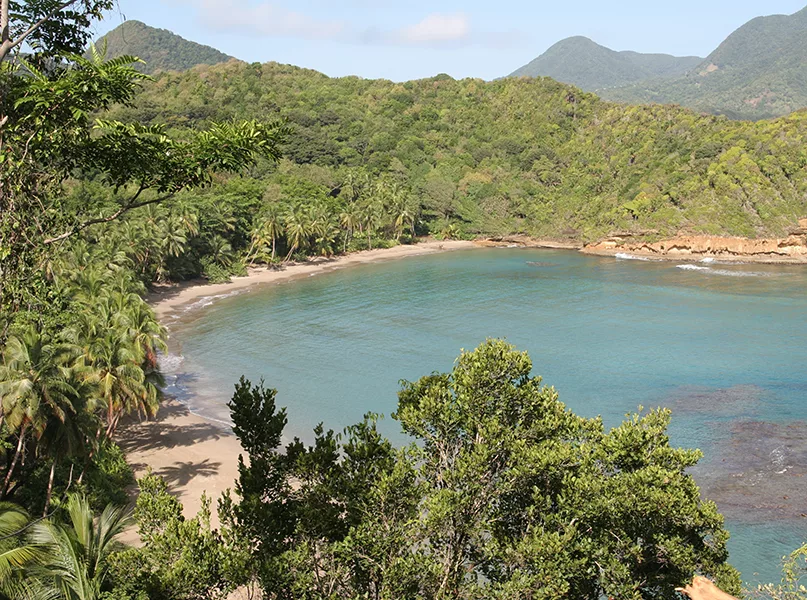
Sleep:
FOR A SECLUDED STAY…
Gems Holdings Limited boasts an impressive property portfolio and is dedicated to supporting the communities and environment in which it operates. Whether you prefer a treehouse-style residence at the boutique 6-star Secret Bay resort, an apartment at Tibay Villas in Portsmouth, or a suite at Fort Young Hotel and Dive Resort, the island’s only all-inclusive hotel in Roseau, you’re guaranteed a luxurious interior to complement the beautiful exterior. Each accommodation offers unique experiences and access to exciting adventures, and there’s even an opportunity to own one of the breathtaking Secret Bay villas.
FOR THE QUINTESSENTIAL AND CHARMING COAST…
Atlantique View Resort and Spa is ideal for exploring and unwinding; perched atop a picturesque mountain in the village of Anse de Mai, guests can enjoy an Atlantic Ocean vista while taking a dip in the three-tiered chandelier pool – the only one of its kind on the island.
The resort has myriad amenities, including a barber and beauty shop, convenience store, gift shop, private beach, yoga sessions, sun deck, picnic area, free coffee and WiFi, and much more to ensure a comfortable stay. Five different types of rooms and suites are available, featuring queen and king-sized beds as well as a deluxe room with two double beds. The on-site restaurant, Coconut Grove, fuses Caribbean and American cuisine and features a rooftop bar for evening drinks.
When exploring away from the resort, one of the most beautiful attractions on the island is Batibou Beach. It features a crescent of gorgeously wild, towering coconut trees that populate the soft golden sand, Atlantic waters calm enough for a swim and a snorkel, and a beach bar where sunbathers can sip on tropical drinks.
Alternatively, Chaudiere Pool is an idyllic waterfall where travellers can experience nature among rugged and verdant forestry and take a refreshing swim to escape the heat in the water, which is so pristine that it reflects the leafy landscape surrounding it.

LANDMARK ATTRACTIONS
The Emerald Pool
In the heart of Dominica, Morne Trois Pitons National Park sits an ethereal green gem – Emerald Pool. Glistening beneath a leafy umbrella, the sun-dappled water shimmers with a rainbow of vert colours, complemented by a waterfall backdrop. Legend has it that taking a dip in this fountain of youth could add 10 years to an explorer’s life, adding to the allure of this enchanting spot.
Champagne Reef
Take a plunge into the sparkling waters of Champagne Reef and explore the thermal springs that release tiny volcanic gas bubbles from the ocean floor. The reef is golden in colour for an enhanced effect, giving the sea a greenish-gold hue. Snorkelling and scuba diving enthusiasts can encounter a variety of sea creatures, including octopuses, rays, hawksbill turtles, seahorses, parrotfish, and frogfish swimming among a vibrant kaleidoscope of red rope, yellow tube, purple vase, and pink, azure sponges.
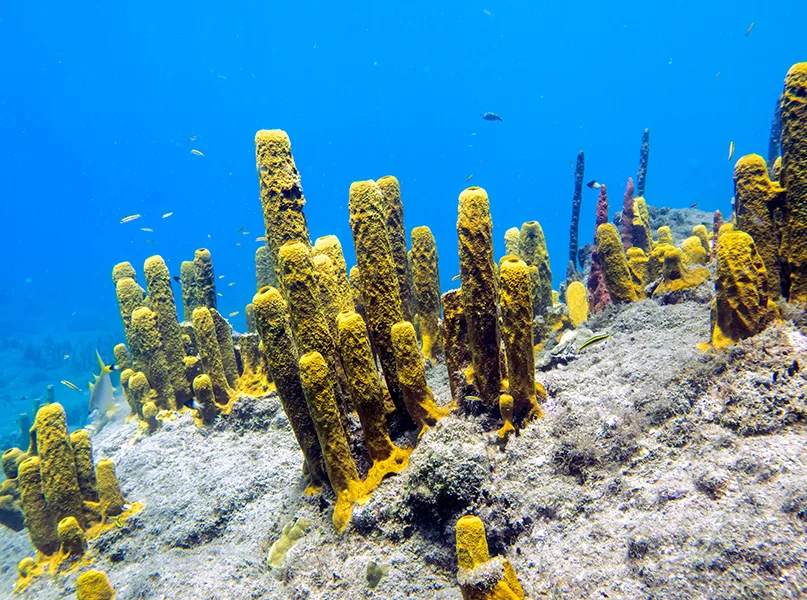
Whale Watching
Dominica’s steep underwater drop-offs create sheltered bays along its western coastline, providing the perfect haven for sperm whales to breed and calve. These magnificent creatures reside there all year long, making this the only place in the world to see this spectacular sight. Whale-watching operators adhere to a strict code of conduct, minimising any disturbances.
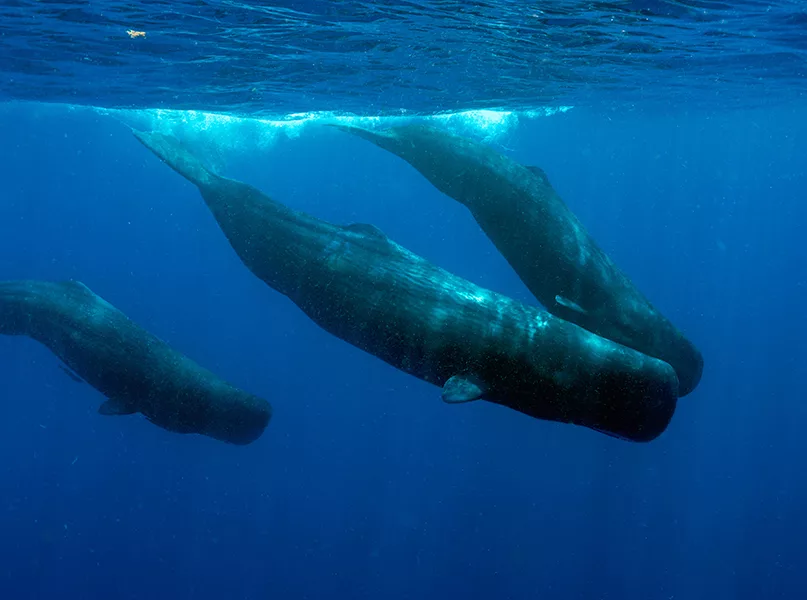
GETTING THERE AND AROUND
Dominica has two airports – Douglas-Charles Airport (DOM), located on the northeastern side of the island about an hour north of the capital city, Roseau, and Canefield Airport (DCF) on the west coast. However, a new option, Dominica International Airport, is currently under construction and is expected to be completed in 2026.
There are no direct flights from the UK or Europe to the island, whilst the US only has a direct flight from Miami, Florida. The only other way to access Dominica directly is from another Caribbean Island. Although, there are regional and international connections via ferry operator, L’Express Des IIes, from Saint Lucia, and the French Islands of Guadeloupe and Martinique.
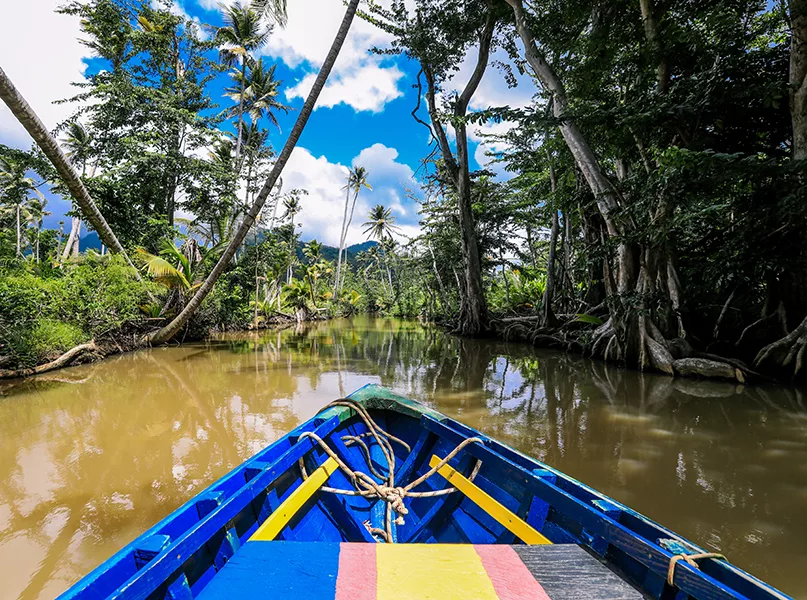
Dominica’s ferry port in Roseau provides three daily and 17 weekly sailings, with the fastest route taking two hours from Martinique’s Fort de France port.
The most efficient mode of transport around the island is by car or taxi. Sonar Car Rentals allows visitors to explore easily, conveniently, and comfortably. Alternatively, there is a reliable bus service, depending on the destination.
Hiking is another excellent way to get around and sightsee simultaneously, with numerous trails for various ability levels. Indeed, Dominica is the Caribbean’s top destination for a walking holiday with its varied canvas of contrasting landscapes, hence earning the nickname “Nature Island of the Caribbean”.


